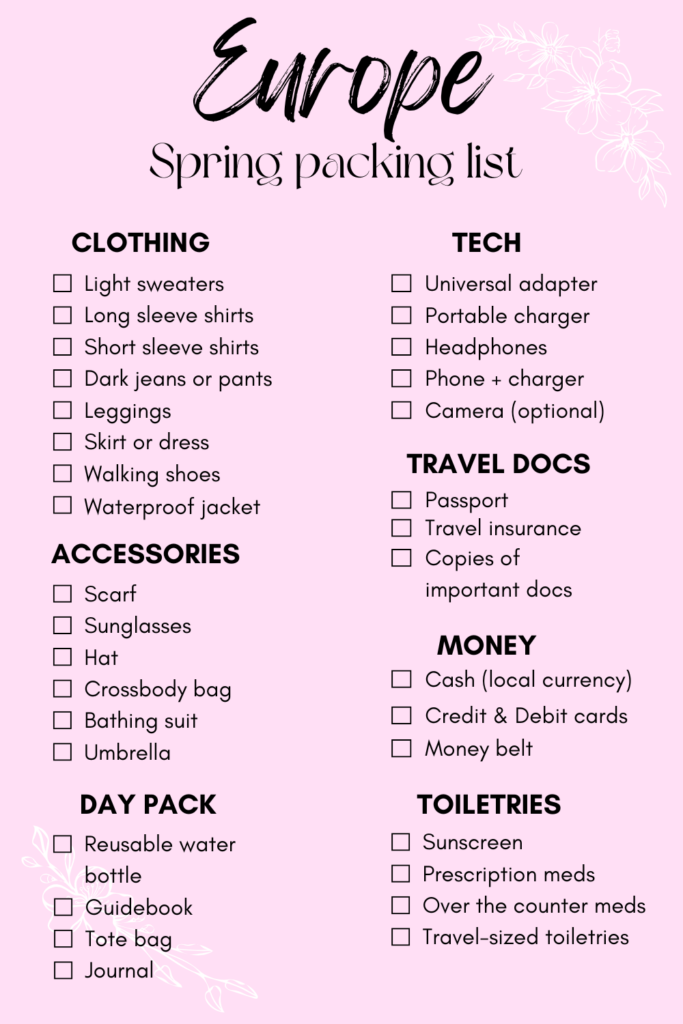Ultimate Packing List for Europe in Spring
Planning a spring trip to Europe and wondering what to pack?
I’ve got you covered!
I lived in Ireland for three years and took many spring trips around the European continent. I know that packing for a trip to Europe in the spring can be tricky. The weather changes quickly, and you might encounter cold mornings, sunny afternoons, and the occasional spring shower.
But don’t worry! With a little planning, you can pack smart and be ready for anything the season throws your way.
In this guide, I’ll walk you through the essentials to pack for Europe in the spring, including clothing, travel must-haves, and a few extras that will make your trip easier and more comfortable. Whether you’re exploring city streets, countryside trails, or seaside towns, this list has you covered. Let’s dive in!
Please note this post may contain affiliate links. If you click on one, I may earn a small commission at no extra cost to you. See my Privacy Policy for more information.
How to Use This Spring Packing List
While I talk about European spring weather in mostly general terms, keep in mind that the weather can vary drastically depending on where you’re headed.
Southern Europe is much warmer than the northern regions, so you’ll want to adjust your clothing based on your specific destinations. For example, you’ll need a warm coat and layers if you’re visiting Dublin in March, but if you’re heading to Sicily or the Amalfi Coast in May, you’ll want lightweight clothing. Always check the weather forecast closer to your trip to help you fine-tune your packing.
This list covers everything you’ll need when packing for Europe in March, April, and May, for the average spring weather and climate conditions throughout Europe.
Short on time? Save this handy Europe in spring packing checklist for later!

What to Pack for Europe in Spring
Clothing
Europe in spring means changeable weather. You’ll want to pack layers and be prepared for colder weather at times.
Lightweight sweaters or cardigans
These are perfect for chilly mornings and can be easily removed as the day warms up. Choose neutral colors to mix and match with your outfits so you can pack lighter and dress them both up and down.

Long-sleeve shirts or blouses
These are ideal for cooler weather or layering under sweaters, as well as being versatile for day-to-night transitions. Pack a mix of styles to suit casual outings or nicer dinners.

Short sleeves or tank tops for warmer days
Spring in Europe can surprise you with warm, sunny afternoons. I like to pack a few short-sleeve shirts for those warmer days. They’re also great for layering under cardigans or jackets so you’re prepared for temperature fluctuations throughout the day.
A waterproof jacket or rain shell
You never know when spring showers are going to fall, so a lightweight rain jacket will keep you dry without taking up too much luggage space. Look for one with a hood to save room if you don’t want to carry an umbrella. If you’re visiting a warmer destination, a simple waterproof rain shell that packs up small is great to have on hand.

Comfortable jeans or pants
Most European countries are still pretty cold in spring, so long pants are a must. I like to bring simple blue jeans that can pair with multiple tops. Dark colors are a good choice since they hide stains (a must when you have to re-wear clothes and may not have access to a laundromat).
Leggings
Great for layering and comfortable as well, leggings are an easy and lightweight layering option for spring travel in Europe. Wear them with a dress, layered under jeans for extra warmth, or even by themselves for a long travel day. They take up little to no room in your suitcase and you’ll be glad you packed them.
A skirt or dress
I don’t always travel with dresses, but it doesn’t hurt to pack one for spring in Europe. You’ll be glad you have a nicer going-out outfit or something flowy on hand for those warmer days. I recommend packing a travel-friendly dress that doesn’t wrinkle easily and can be layered with tights if it’s chilly.

Comfortable walking shoes
No packing list for Europe is complete without sensible walking shoes. A trip to Europe, in any season, means you’ll be doing lots of walking.
A pair of white sneakers is my preferred European travel shoe. They are comfortable for spending hours on your feet and pair well with most outfits (including dresses). I don’t normally travel with multiple pairs of shoes, but an alternative to sneakers are comfortable, water-resistant boots. I often travel with just my Dr. Marten’s boots since they’re stylish, comfortable, and protect my feet from the rain.
Accessories
Scarf
For spring in Europe, I recommend packing a light scarf to layer for added warmth. The scarf can double as a wrap if needed, or as a cover if you go into a church.
Sunglasses
Even on cooler days, the spring sun can be bright, so protect your eyes and enjoy the views. Polarized lenses are the best as they reduce glare, but a cheap pair you won’t cry over if they get scratched or lost is fine as well.
Hat
Don’t forget to pack a hat for your European trip. While many spring days can be dreary and overcast, you never know when the sunshine will come. And when it does, you’ll wish you had a hat to protect your skin.
Bathing suit
If you plan to visit warmer destinations (like Malta or southern Italy), coastal areas, or spa towns like Budapest, then don’t forget to pack a swimsuit. It’s better to have it and not need it than to miss out on a great experience.
Crossbody bag
A good crossbody bag is a general travel essential. I opt for utility over fashion, and I love my Stubble&Co. travel bag because it’s cute, sturdy, and has zippered pockets that keep your belongings safe from pickpockets. I’ve traveled with it all over Europe and love it.

A compact umbrella for spring showers
Easy to carry in your daypack, this is a lifesaver when unexpected rain hits. I recommend bringing an umbrella that’s small but durable, as well as wind resistant.
Other European Travel Essentials
Travel Documents
Passport (with necessary visas)
Your passport is your most important travel document, so double-check that it’s valid for at least six months after your return date. If visas are required for your destination, make sure you have those sorted well in advance.
Copies of important documents (stored digitally and printed)
Make sure you travel with both digital and physical copies of your passport, travel insurance, and other important documents. This can be a lifesaver if the originals are lost or stolen. Store digital versions in a secure cloud service for easy access. I keep everything in my Google Drive so I know where it is.
Travel insurance details
Accidents and emergencies can happen, so having travel insurance is a must. Keep a printed copy of your policy details and contact numbers handy.
Tech
Universal adapter
European outlets differ from those in the US, and if you are traveling to England or Ireland they have different outlets than the rest of Europe. Because of this, I recommend traveling with a universal adapter for charging your devices. Look for one with multiple USB ports to save space so you can charge multiple items at once.
Portable charger/power bank
If you plan to take lots of videos and photos on your phone, or you’ll be using your phone a lot for maps or entertainment, then be sure to pack a portable charger. This will ensure your phone stays powered during long travel days and you won’t get stuck searching for a place to plug in.
Headphones
I never leave home without a set of headphones. Whether for watching movies and listening to music on the airplane or for following a museum audioguide, make sure you pack your preferred audio headset.
Phone and charging cables
Don’t forget to pack cables for all your devices. It’s worth bringing an extra in case one gets lost or damaged.
Camera (optional)
If you love photography, your camera and camera gear as musts. However, if you’re short on space, your smartphone camera is perfect for capturing the moments you’ll want to remember forever.
Money
Credit/debit cards with no foreign transaction fees
Avoid unnecessary fees by using cards designed for international travel. Make sure to notify your bank of your travel dates to prevent security blocks.
Cash
Having some cash is helpful for small purchases, tipping, or places that don’t accept cards. You can withdraw from ATMs upon arrival to avoid high exchange rates. Also, many public restrooms charge a small fee, so keep some coins handy.
Money belt
Especially important in cities and touristy areas with reputations for theft, money belts are an essential travel item. A discreet money belt keeps your valuables out of sight and secure, giving you peace of mind while you travel.
Toiletries & Medications
Travel-sized toiletries
To meet airline regulations, make sure you keep any carry-on toiletries under 100mL. I always travel with a set of regulation-sized reusable silicone toiletry bottles. Not only do they carry the perfect amount of shampoo or conditioner, but I never have to worry that I’m bringing on too much liquid or that they’ll explode in my carry-on.
Sunscreen (yes, even in spring!)
The European sun can be harsh, even in the spring. Protect your skin from UV rays, even on cloudy days. You never know when the sun will pop out, and nothing ruins a vacation quite like a sunburn.
Prescription medications
Bring enough medication for your trip, plus a little extra in case of delays. I also recommend keeping a copy of your prescription in case you need a refill while abroad.
Over-the-counter meds
Pack essentials like pain relievers, allergy meds, and remedies for colds or upset stomachs. Not only can these can save you a trip to the pharmacy, but your favorite brands may not be easily available in other countries.
Daypack Items
A lightweight backpack is essential when traveling in Europe. For spring, these are the items I recommend loading into your day pack:
Reusable water bottle
Stay hydrated while reducing plastic waste. Tap water in most European countries is safe and drinkable, so there’s no need to constantly purchase water in single-use plastic bottles. To save space, look for a collapsible bottle that stores easily when not in use.
Guidebook
I always prefer to carry a physical guidebook with me when I travel. That way I can easily access the information I need and not worry about technical problems or difficulties. In Europe, my favorite guidebook companies are Rick Steves and Lonely Planet.
Notebook or travel journal
I never go anywhere without a notebook. It’s the best way to hold onto your memories and a great keepsake to look back on.
Lightweight foldable tote for shopping
Many European countries charge for shopping bags, so having tote bag on hand is both practical and eco-friendly. I always pack a fold-up tote for carrying groceries or visiting markets.

Final Thoughts
I hope this list helped you pack for a spring vacation in Europe! If you only take away one thing from this travel packing list, please remember that spring weather is changeable and layering is essential. Plan your travel wardrobe with layers in mind so you’ll be ready for both the rain and the sunshine.
Did I miss a European spring packing essential? Let me know if the comments!
